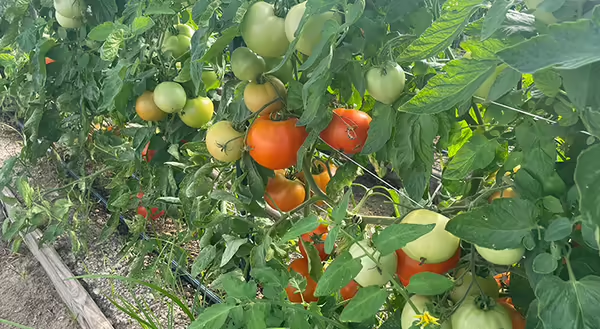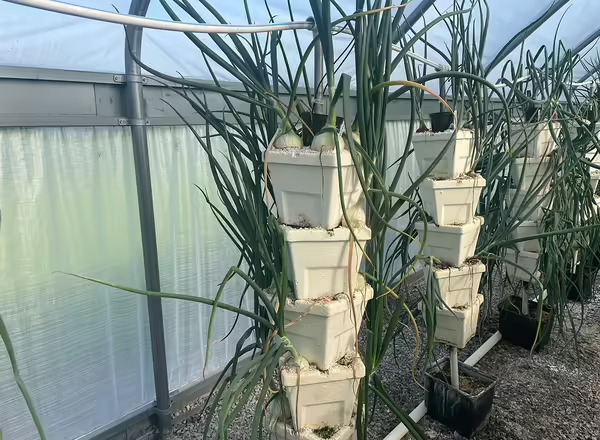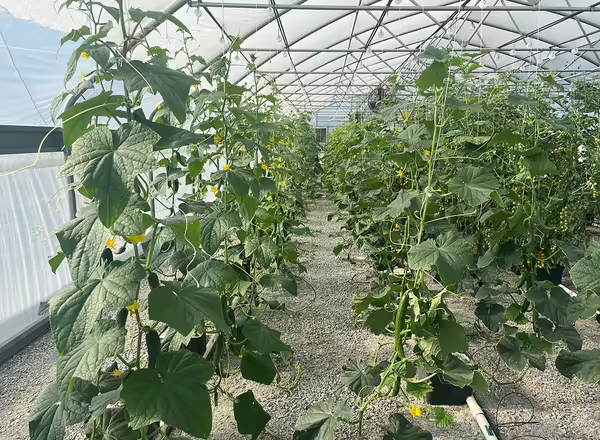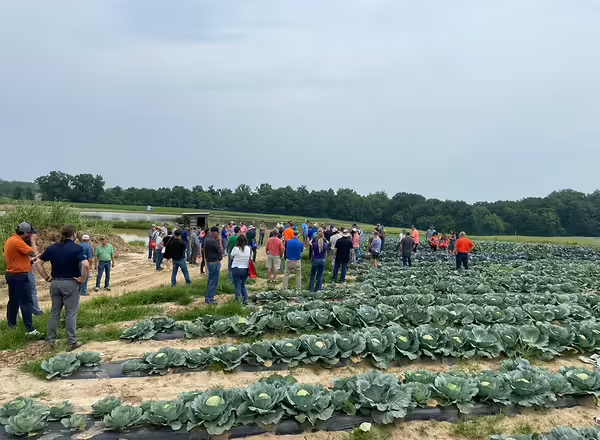
Tomato and pepper harvests began during the middle of June, but the last week of June really saw an increase in ripe tomatoes. Typically, with transplants set out the first week of April, tomato harvest begins in late June, but the first really big pick is around July 6 or 7. This year I think the prolonged time with cloudy, overcast skies and temperatures below normal impacted the tomato plants in a positive manner. The plants look healthy, have a uniform fruit set and are ripening earlier than normal. Some years when temperatures get too high and stay high in June and early July, the tomato fruit from the first and second clusters don’t ripen, and then in mid-July all of the fruit ripen at once. This creates issues for both marketing and production strategies. Shade cloth has not been used over the two in-ground raised bed high tunnels at DSAC, but they will be installed for use next year.
The pepper crop is also looking good. ‘Aristotle’ bell pepper variety performed well last year and the first harvest from this week yielded many nice large to extra large fruit. This pepper is uniform and blocky with thick walls and ripens to red. Other peppers harvested this past week included bananas, jalapenos, and ‘Tequila’ bells that are purple at maturity.
In comparing the cover crop/cut flower treatment tunnel to the control tunnel (no cover crops or cut flowers), the treatment tunnel has a large number of aphids in multiple pockets throughout the tunnel, but the control tunnel has very few aphid pests at this time. Predator insect pests that have been observed in the treatment tunnel include a few lady beetles, green lacewings, and many small spiders. To date, one preventive fungicide application and four applications of a Bt insecticide for worm control have been made in the tunnels.
Hydroponic Tunnel
This season, the vertical stack growing system is being utilized to look at hydroponic onion production. Three stacks had bunching onions, which were harvested on June 5. With 20 growing spots per stack, the three varieties yielded a total weight of 3 pounds each. They looked uniform, with nice green tops, but the flavor was NOT nice at all. They each had a very strong, pungent, hot, like a turnip bite to them that was not pleasing. They should have been harvested much sooner – lesson learned. The bulb onions and shallots are starting to show signs of reaching maturity as the green tops are starting to brown up. Yield data is being collected on these as well. And yes, if the bulb isn’t sitting high enough out of the perlite, they will bust the corner of the Styrofoam cubes as they size to baseballs and beyond.
In hopes of reducing the volume of cucumbers harvested each day and spreading harvest out across a longer season, half as many plants were transplanted in May. Typically, our spacing between the dutch buckets is 18 inches with two plants per bucket, but this year we skipped a space, stretching the spacing to 36 inches between buckets with two plants per bucket. The fruit set is better than any other year, and interestingly enough, harvests have increased instead of decreasing. Currently, daily harvests are averaging 2.5 cucumbers per plant. Another set of cucumber transplants will be ready to set out in mid to late July in another set of buckets in the empty spaces in the row. The original plants will then be removed, keeping the spacing at 36 inches. Harvest data is being collected in order to see if and how the spacing change affected yields.



Summer Hort Field Day
Flamm’s Orchard hosted a great summer hort field day this year on June 12. The morning started with a wagon tour with stops at a peach tree rootstock study, sonic spray technology demonstration, strawberry plasticulture variety comparisons, apple nutrient spray study, and large-scale vegetable production. The weather was beautiful, the lunch was delicious, networking and sharing of information was abundant, and the afternoon ended with a tour of their new processing facility. If you have not attended a summer hort field day, I highly recommend making the time next year, as each host farm offers a wealth of information for Illinois specialty crop producers.
The next southern Illinois summer twilight meeting will be held at the Dixon Springs Ag Center on Thursday, July 17 from 6 to 8 pm. Since 2021, the on-site high tunnels have served as a test site for research studies on biological insect control. Specialty Crops Entomologist Kacie Athey will discuss lessons learned from the four-year study, as well as insect identification and integrated pest management options for insect pests in high tunnels. Observations from three years of no-till cover cropping ahead of tomato and pepper transplanting in high tunnel production, along with basic high tunnel vegetable production practices, will also be shared. The campus farm robotics team will be onsite to demonstrate robotic harvesting and discuss other ways to use robotic technology in a controlled environment production system. To register for this meeting, visit go.illinois.edu/twilightseries or call Bronwyn Aly at 618-695-2441.